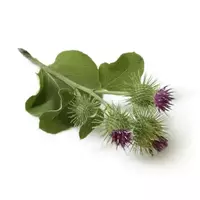Lopukh (burdock)

Lopukh (burdock) is not only a weed with which domestic gardeners-gardeners do not get tired of fighting on their personal plots. The two-year-old herb burdock or Arctium belongs to the Astrov family, and has long been used by humans for culinary purposes, as well as as an effective and healing remedy for traditional medicine. Perhaps in our time, due to the abundance on the shelves of grocery stores, burdock (burdock) does not enjoy the same popularity.
However, some 50-100 years ago, burdock plants were considered not only a tasty treat, but also a source of vitamins, as well as other natural compounds that bring significant benefits to the human body. True, for the sake of fairness, it should be noted that until now the root of burdock is in stable demand and popular. In addition, green leaves and burdock shoots continue to be used for both culinary and medical purposes.
The beneficial properties of burdock (burdock) have been known to humans since ancient times. Moreover, the distinctive and unique healing properties of burdock are due to the chemical composition of the plant. Even a quick look at the chemical composition of a burdock is enough to realize what colossal benefits a plant can bring to humans. For example, burdock (burdock) contains a large amount of vitamins of group B, C, E, PP, as well as K. In addition, burdock contains a sufficient amount of useful natural compounds in its chemical composition, such as magnesium, selenium, zinc, manganese, iron or phosphorus.
Types of burdock
Currently, botanists have discovered and described a sufficient number of species of burdock (burdock). As a rule, all species of burdock differ from each other in appearance and habitat. In addition, the useful properties and other consumer characteristics of the plant depend on the species of burdock. Among the most famous and common in the territory of the Russian Federation, the following species of burdock (burdock) can be distinguished - Big Lopukh or Arctium lappa, as well as Felt Lopukh or Arctium tomentosum.
All components of the burdock plant are used by humans. Leaves and green shoots, as well as rhizomes, are eaten or made on the basis of a plant of decoctions, infusions and other medicines related to folk medicine. The burdock rhizome contains a large amount of natural essential oils, as well as tannins. Burdock seeds also benefit the human body, since their chemical composition contains up to 30% fatty amino acids and other organically active compounds.
The benefits of burdock
The benefits of burdock (burdock) lie in the chemical composition of the plant. Which, in principle, is not surprising. Moreover, given the fact that the benefits of burdock (burdock) were discovered by humanity in ancient times. Lopukh can be ranked among the list of ancient means of traditional medicine. In addition, official medicine has been using the useful properties of burdock in the treatment of certain types of diseases for a decade. Lopukh refers to natural honeybees. Burdock honey is famous for its incredible benefits for humans.
The harms of burdock
However, there is not only benefit, but also harm to burdock (burdock). Burdock can have a negative effect on those people who suffer from individual intolerance to the plant. However, burdock (burdock) can only be harmed if the plant is constantly eaten in large quantities. Subject to all precautions, burdock can only provide exceptional benefits to human health. True, you should not take any kind of means, albeit on the basis of natural material, without prior consultation with specialists.
burdock (burdock) 72 kCal
Energy value of burdock (burdock) (Ratio of proteins, fats, carbohydrates - ju):
Proteins: 1.53 g (~ 6 kCal)
Fats: 0.15g (~ 1 kCal)
Carbohydrates: 14.04 (~ 56 kCal)
Energy ratio (bj | y): 9% | 2% | 78%
 Español
Español Français
Français Português
Português Русский
Русский 简体中文
简体中文 繁體中文
繁體中文 日本語
日本語 한국어
한국어 العربية
العربية Türkçe
Türkçe Қазақ
Қазақ Deutsch
Deutsch Italiano
Italiano Українська
Українська
